United States Bicentennial
| United States Bicentennial | |
|---|---|
 | |
| Date(s) | April 1, 1975 – July 4, 1976 |
| Location(s) | United States of America |
| Previous event | Sesquicentennial(1926) |
| Next event | Semiquincentennial(2026) |
| Activity | 200th anniversary of the adoption of theDeclaration of Independence |
| Organized by | American Revolution Bicentennial Commission (1966–73) American Revolution Bicentennial Administration (1973–76) |
TheUnited States Bicentennialwas a series of celebrations and observances during the mid-1970s that paid tribute to historical events leading up to the creation of the United States as an independent republic. It was a central event in the memory of theAmerican Revolution.The Bicentennial culminated on Sunday, July 4, 1976, with the 200th anniversary of the adoption of theDeclaration of Independenceby theFounding Fathersin theSecond Continental Congress.
Background
[edit]The nation had always commemorated the founding as a gesture of patriotism and sometimes as an argument in political battles. Historian Jonathan Crider points out that in the 1850s, editors and orators both North and South claimed their region was the true custodian of the legacy of 1776, as they used the Revolution symbolically in their rhetoric.[1]
The plans for the Bicentennial began whenCongresscreated theAmerican Revolution Bicentennial Commissionon July 4, 1966.[2][3][4][5]Initially, the Bicentennial celebration was planned as a single city exposition (titled Expo '76) that would be staged in eitherPhiladelphiaorBoston.[6]After 6½ years of tumultuous debate, the Commission recommended that there should not be a single event, and Congress dissolved it on December 11, 1973, and created theAmerican Revolution Bicentennial Administration(ARBA), which was charged with encouraging and coordinating locally sponsored events.[7][8][9][10]David Ryan, a professor atUniversity College Cork,notes that the Bicentennial was celebrated only a year after theFall of Saigonin 1975 and that theFord administrationstressed the themes of renewal and rebirth based on a restoration of traditional values, giving a nostalgic and exclusive reading of the American past.[11]
Logo
[edit]
Bruce N. Blackburn,co-designer of the modernizedNASA insignia,designed the logo.[12][13]The logo consisted of a white five-point star inside a stylized star of red, white and blue. It was encircled by the inscriptionAmerican Revolution Bicentennial 1776–1976inHelveticaRegular. An early use of the logo was on a 1971 US postage stamp. The logo became a flag that flew at many government facilities throughout the United States and appeared on many other souvenirs and postage stamps issued by thePostal Service.NASA painted the logo on theVehicle Assembly Buildingat theKennedy Space Centerin 1976 where it remained until 1998 when the agency replaced it with its own emblem as part of 40th anniversary celebrations.[14]
1973 events
[edit]
Boston Oil Party
[edit]In 1973, on the shores of Boston Harbor, activists and history enthusiasts recreated theBoston Tea Party.Participants and spectators boasted signs and effigies, but no longer against the English crown and taxes. This protest was a call for "environmental protection, racial justice, an end to corporate profiteering, and the impeachment of Richard Nixon."[15]Several people threw packages and oil barrels labeled "Gulf Oil"and"Exxon"intoBoston Harborin symbolic opposition to corporate power, in the style of the Boston Tea Party.[16]This reenactment later was termed as the "Boston Oil Party", and roughly 10,000 people witnessed the dumping of oil conglomerates, as well as the hanging of an effigy of President Nixon.[17]
1975 events
[edit]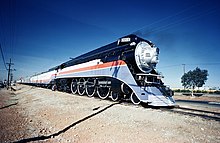
The official Bicentennial events began April 1, 1975, when theAmerican Freedom Trainlaunched inWilmington, Delawareto start its 21-month, 25,388-mile (40,858 km) tour of the 48 contiguous states.[18]
On April 18, 1975, PresidentGerald Fordtraveled toBostonto light a third lantern at the historicOld North Church,symbolizing America's third century.[19]The following day, April 19, he delivered a major address inConcord, Massachusettsat theOld North Bridgewhere the "shot heard round the world"was fired, commemorating the 200th anniversary of theBattles of Le xing ton and Concordwhich began the military aspect of the American Revolution.[20]According to theNew York Times"more than 2,000 spectators were on hand" as canons were fired and a Paul Revere reenactor rode through announcing the arrival of British Troops.[21]
On December 31, 1975, the eve of the Bicentennial Year, Ford recorded a statement to address theAmerican peopleby means of radio and television broadcasts.[22]Presidential Proclamation 4411 was signed as an affirmation to the Founding Fathers of the United States principles ofdignity,equality,government by representation,andliberty.[23]
1976 events
[edit]1976 festivities included elaboratefireworksin the skies above major US cities. President Ford presided over the display in Washington, D.C. which was televised nationally. Celebrations in cities and towns across the nation opened into full effect including celebrations such asOperation Sail(Op Sail), a large international fleet parade of tall-mastedsailing shipsgathering first in New York City onIndependence Dayand then in Boston about one week later. Other large scale events such as reenactments, parades, and booms in commercialized commemoration spread across the nation as the year went on.
New York
[edit]In addition to the presence of the 'tall ships', navies of many nations sent warships to New York harbor for anInternational Naval Reviewheld the morning of July 4. President Ford sailed down theHudson Riverinto New York harbor aboard theguided missile cruiserUSSWainwrightto review the international fleet and receive salutes from each visiting ship, ending with a salute from the Britishguided-missile destroyerHMSLondon.The review ended just aboveLiberty Islandat around 10:30 am.
Washington, D.C.
[edit]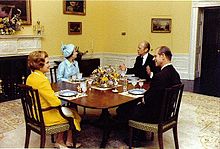
Johnny Cashserved as the Grand Marshal of the US Bicentennial parade.[24]
The event was attended byQueen Elizabeth IIandPrince Philip.The royal couple made a state visit to the United States, toured the country, and attended other Bicentennial functions with President and Mrs. Ford. Their visit aboard theRoyal YachtBritanniaincluded stops in Philadelphia, Washington, D.C., Virginia, New York, Connecticut, and Massachusetts.
TheSmithsonian Institutionopened a long-term exhibition in itsArts and Industries Buildingreplicating the look and feel of the 1876Centennial Expositionin Philadelphia, including artifacts from earlier exposition. The BicentennialFestival of American Folklife,a collaboration of the Smithsonian with thousands of national and international scholars, folk artisans, and performers, hosted programs in the western part of the National Mall five days a week for twelve weeks in the summer of 1976.[25]The Smithsonian also opened the new home of theNational Air and Space Museumon July 1, 1976.[26]
Government celebration
[edit]George Washingtonwas posthumously appointed to the grade ofGeneral of the Armies of the United Statesby the congressional joint resolutionPublic Law 94-479passed January 19, 1976, with an effective appointment date of July 4, 1976.[27]This restored Washington's position as thehighest-ranking military officer in US history.[Note 1]
NASA commemorated the Bicentennial by staging a science and technology exhibit housed in a series of geodesic domes in the parking lot of the Vehicle Assembly Building (VAB) calledThird Century America.An American flag and the Bicentennial emblem were also painted on the side of the VAB; the emblem remained until 1998, when it was painted over with the NASA insignia. NASA planned forViking 1to land on Mars on July 4, but the landing was delayed to July 20, the anniversary of theApollo 11lunar landing. On the anniversary of thesigning of the Constitution,NASA held the rollout ceremony of thefirst Space Shuttle(which NASA had planned to nameConstitutionbut was, instead, named "Enterprise" in honor ofits fictional namesakeon the television seriesStar Trek[28]).

Delaware crossing reenactment.
On November 20 and 21 of 1976, participants immersed themselves in the era by donning period-accurate uniforms and equipping themselves with the tools and weaponry characteristic of that Christmas night over two centuries prior.[29]The reenactment unfolded as a grand spectacle, featuring a flotilla of boats navigating the icy currents of the Delaware River.

Since then, theCrossing the Delawarereenactment has occurred every year to relive and recognize this moment.
Philadelphia
[edit]While in Philadelphia on July 6, 1976, Queen Elizabeth presented the Bicentennial Bell on behalf of the British people. The bell is a replica of the Liberty Bell, cast at the same foundry—Whitechapel Bell Foundry—and bearing the inscription "For the People of the United States of America from the People of Britain 4 July 1976 LET FREEDOM RING."[30]
Los Angeles
[edit]Disneylandand theMagic KingdomatWalt Disney WorldpresentedAmerica on Parade,an elaborate parade celebrating American history and culture, and featured theSherman Brothers' song "The Glorious Fourth".The parade featured nightly fireworks and ran twice daily from June 1975 to September 1976.
Los Angeles observances included the Bicentennial Parade of 1976 on Wilshire Boulevard,[31][32][33]and the Los Angeles City Schools Bicentennial Pageant atLos Angeles Memorial Coliseum,broadcast as part ofHappy Birthday, America(NBC), hosted byPaul Anka,[34][35][36][37]Pacific 21,a bicentennial exhibition and conference center,[38]and Knott's Berry Farm bicentennial celebration.[39]
Professional sports celebrations
[edit]The overall theme of the entertainment ofSuper Bowl X,held January 18, was to celebrate the Bicentennial. Players on both teams, thePittsburgh Steelersand theDallas Cowboys,wore a special patch with the Bicentennial Logo on their jerseys; the Cowboys also added red, white, and blue striping to their helmets throughout the 1976 NFL season. The halftime show, featuring the performance groupUp with People,was entitled "200 Years and Just a Baby: A Tribute to America's Bicentennial".
TheUnited States Olympic Committee(USOC) initiated bids to host both the 1976 Summer and Winter Olympic Games in celebration of the Bicentennial. Los Angeles bid for the1976 Summer Olympicsbut lost toMontreal.Denverwas awarded the1976 Winter Olympicsin 1970, but concern over costs ledColoradovoters to reject a referendum to fund the games and theInternational Olympic Committeeawarded the games toInnsbruck,Austria, the 1964 host.[40]As a result, there was no Olympics in the United States in 1976 despite a last minute offer fromSalt Lake Cityto host. However,Lake Placidwould host the1980 Winter Olympics,Los Angeles would eventually be awarded the1984 Summer Olympics,and Salt Lake City would also eventually be awarded the2002 Winter Olympics.

As site of theContinental Congressand signing of the Declaration of Independence,Philadelphiaserved as host for the1976 NBA All-Star Game,the1976 National Hockey League All-Star Game,the1976 NCAA Final Four,and the1976 Major League Baseball All-Star Gameat which President Ford threw out the first pitch.[41]The1976 Pro Bowlwas an exception and was played in New Orleans, likely due to weather concerns.
Other
[edit]Local observances included painting mailboxes and fire hydrants red, white, and blue. A wave of patriotism and nostalgia swept the nation and there was a general feeling that the irate era of thecivil rights movement,theVietnam War,and theWatergateconstitutional crisis of 1974 had finally come to an end.
In the summer of 1976, the city of South Bend, Indiana, embarked on a unique project to commemorate the United States Bicentennial: painting its fire hydrants in vibrant colors and patriotic designs. Over four decades later, many of South Bend's painted fire hydrants still stand as reminders of America's Bicentennial celebration.[42]
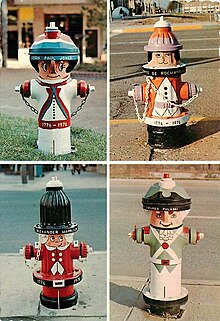
Bell Telephone CompanycommissionedStanley Meltzoffto create a cover for its 1976 directory to commemorate both the Bicentennial and the centennial of the invention of thetelephone.Based onNorman Rockwell'sThe Gossips,Meltzoff depicted America's great historic and iconic figures using the telephone. It became the biggest selling directory in Bell's history.[43]
Many national railroads andshortlinespainted locomotives or rolling stock in patriotic color schemes, typically numbered 1776 or 1976, and model railroad manufacturers quickly released bicentennial locomotives which were popular among children and adults. Many military units marked aircraft with special designs in honor of the Bicentennial.John Warnerserved as ARBA director.[44]
TheNew Jersey Lotteryoperated a special "Bicentennial Lottery" in which the winner received $1,776 per week (before taxes) for 20 years (a total of $1,847,040).
The Bicentennial Wagon Train Pilgrimage began a journey fromBlaine, Washingtonon June 8, 1975, concluding atValley Forge, Pennsylvaniaon July 4, 1976.[45][46]Thewagon trainpilgrimage traced the originalcovered wagontrade and transportation routes across the United States encompassing theBozeman Trail,California Trail,Gila Trail,Great Wagon Road,Mormon Trail,Natchez Trace Trail,Old Post Road,Old Spanish Trail,Oregon Trail,Santa Fe Trail,andWilderness Road.[47][48]
Karen Steele was the first baby born on July 4, 1976, 12 seconds after midnight, and was referred to as the "Bicentennial Baby". She was featured onThe Today ShowandGood Morning America,and received commemorations from President Ford, New Jersey GovernorBrendan Byrne,and a host of other notables.
Many commercial products, including sports, apparel and collectibles, appeared in red, white, and blue packages in an attempt to tie them to the Bicentennial. Liberty, a brand of Spanish olives, sold their product in glass jars replicating the Liberty Bell during that time. Products were only permitted to display the trademarked Bicentennial logo by paying a license fee to ARBA.
Ceremonial coinage
[edit]The US government also commemorated the Bicentennial through the creation of new designs on national currency. The creation of the ceremonial coinage was both a way to get the American public involved in celebrating the bicentennial, and a way to encourage Americans to collect and purchase more bicentennial memorabilia.
-
Reverse of the Bicentennialquarter,minted 1975–1976
-
Reverse of the BicentennialKennedy half dollar,minted 1975–1976
-
Reverse of the Bicentennial dollar (Type 2), minted 1975–1976
Bicentennial on screen
[edit]Television
[edit]Related network television programs aired July 3–4, 1976
[edit]- The Great American Celebration,a 12-hour syndicated entertainment program hosted byEd McMahonand airing the night of July 3
- The Inventing of America(NBC), a two-hour BBC co-production reviewing 200 years of American technological innovations and their impact on the world, co-hosted byJames BurkeandRaymond Burr[50][51]
- In Celebration of US(CBS), a 16-hour coverage hosted byWalter Cronkite
- The Glorious Fourth(NBC), a 10-hour coverage hosted byJohn ChancellorandDavid Brinkley
- The Great American Birthday Party(ABC), hosted byHarry Reasoner
- Happy Birthday, America(NBC), hosted byPaul Ankafrom theLos Angeles Memorial Coliseum[37]
- Bob Hope's Bicentennial Star-Spangled Spectacular(NBC)
- Best of the Fourth(NBC), recap with John Chancellor and David Brinkley
- July 4 satellite broadcast of theUniversity of North TexasOne O'Clock Lab Bandlive performance in Moscow (NBC), sponsored by theUS Department of State
- Days of Liberty(WABC-TV—New York), an animated holiday special
- Goodbye America(PBS), a mock "newscast" re-enacting a 1776 debate in theHouse of Commonsconcerning the future of theThirteen Colonies
- Eastward Ho!(WPSX-TV), a half-hour documentary about the Bicentennial Wagon Train, produced byPennsylvania State University(Penn State). Includes the show troupe which traveled with the wagon train and performed at the campsite each night.
TheBicentennial Minutewas a series of short vignettes aired on CBS from 1974 through the end of 1976 to mark the occasion.
Saturday morning Bicentennial programs
[edit]In the months approaching the Bicentennial,Schoolhouse Rock!,a series of educational cartoon shorts running on ABC between programs on Saturday mornings, created a sub-series called "History Rock", although the official name was "America Rock". The ten segments covered various aspects of American history and government. Several of the segments, most notably "I'm Just a Bill"(discussing the legislative process) and" The Preamble "(which features a variant of the preamble of the Constitution put to music), have become some ofSchoolhouse Rock'smost popular segments.
In 1974, CBS aired a new animatedArchieseries on Saturday mornings calledThe U.S. of Archie;16 episodes were made and were shown in reruns until September 1976.
Films
[edit]| External videos | |
|---|---|
For the Bicentennial celebration, Hollywood filmmakerJohn Hustondirected a short movie—Independence(1976)—for the USNational Park Servicewhich continues to screen atIndependence National Historical Parkin Philadelphia.[citation needed]
The 1976 filmRockycited the Bicentennial in several scenes, mostly duringApollo Creed's entering;Carl Weathersdressed first asGeorge Washingtonand then asUncle Sam.[citation needed]
The oversized vehicle inThe Big Bushad a scene in its Bicentennial Dining Room.
Gifts for the nation
[edit]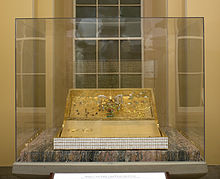
A number of nations gave gifts to the US as a token of friendship.
The United Kingdom loaned one of the four existing copies ofMagna Cartafor display in theUS Capitol.The document was displayed in a case designed by artistLouis Osmanconsisting of gold, stainless steel, rubies, pearls, sapphires, diamonds, and white enamel. This was on a base ofpegmatiteand Yorkshiresandstone.The document was displayed atop a gold replica from June 3, 1976, until June 13, 1977, when it was returned. The case and gold replica remain on display in the Capitol.[52]
Canada through theNational Film Board of Canadaproduced the bookBetween Friends/Entre Amiswhich was a photographic essay of life along the US-Canada border. The book was given to libraries across the US and special editions were presented to President Ford and other officials.[53][54]
The government of France andMusée du Louvreassembled an exhibit of paintings in cooperation with theDetroit Institute of Artsand theMetropolitan Museum of Artthat traveled toDetroitand New York City after being shown in Paris. The exhibit, entitledFrench Painting 1774–1830: The Age of Revolution,included the work of 94 French artists from that period. Many of the 149 works in the exhibit had never been seen outside France and includedLiberty Leading the PeoplebyEugène Delacroix,Jupiter and ThetisbyJean Auguste Dominique Ingresand a portrait ofMaximilien RobespierrebyAdélaïde Labille-Guiard.[55]
Japan's government constructed and furnished the 513-seat Terrace Theatre ofKennedy Centerin Washington. Many of the original furnishings were removed when the theater was renovated between 2015 and 2019.[56]Fifty-threebonsaitrees from the Nippon Bonsai Association were donated to theUS National Arboretum.[57]
King Juan Carlos IandQueen Sofía of Spainpresented sculptures ofBernardo de Gálvez,a hero of theAmerican Revolutionary Warperiod and laterViceroy of New Spain;andDon Quixote,Cervantes'fictional hero, on June 3, 1976, on behalf of their nation. The Gálvez sculpture is in a park at Virginia Avenue at 21st Street NW, which has been named Galvez Park.[58]The Don Quixote sculpture was installed nearby on the grounds of The Kennedy Center. Spain's gift also included an exhibit at theNational Gallery of Artof eightGoyamasterpieces from the collection ofMuseo del Prado.[59][60]
King of NorwayOlav V,Prime Minister of NorwayOdvar Nordli,and the Norwegian government established the Vinland National Health Sports Center inLoretto, Minnesota.[61]
Gallery
[edit]- Celebrating the United States Bicentennial
-
Italian tall shipAmerigo Vespucciin New York Harbor during the celebration
-
Norwegian rigged shipChristian RadichatOperation Sailon July 4, 1976
-
Polish three mast shipDar Pomorzaduring the Parade of Sail on July 4, 1976
- United StatesBicentennial Era Postage Stamps
-
John Trumbull's 1818 oil painting depicting the introduction of theDeclaration of Independenceto the Continental Congress
-
Archibald Willardc. 1875oil paintingThe Spirit of '76depicting afifeplayer and two drummers leading theContinental Armyduring the American Revolutionary War
-
Patriotsutilizing aprinting presswhile examining a colonial pamphlet
-
1773 depiction of the Boston Tea Party showing chests ofBritish teabeing dumped into Boston Harbor on a late night opposing theTea Actenacted byGreat Britain
-
Haym Salomonwas a colonialpaymasterwho raised money to help finance the American Revolution.
-
Peter Franciscoparticipated at theBattle of Camdenwhere he physically seized a 1000-poundcannonwhile departing the battleground occupied byBritish Redcoats.
-
Salem Poorparticipated at theBattle of Bunker Hilland was credited with wounding British Army officerJames Abercrombie.
-
Sybil Ludingtonis said to have ridden through the night to adviseminutementhat British Redcoats were burningDanbury, Connecticut;these accounts, originating from theLudington family,are questioned by modern scholars.[62][63][64]
-
Patriots acknowledging the spirit of independence by honoring the drummer who marched into battle or the drum as an instrument to alert neighbors of British Redcoats
-
Patriots acknowledging the spirit of independence by honoring thepost riderswho delivered mail on horseback
- Other Commemorative Items
-
Six different Bicentennial buttons designed and sent by two art teachers to President Gerald Ford
-
A box of 15 billiard balls specifically designed to commemorate the Bicentennial
-
Commemorative pewter Bicentennial thermometer depicts an eagle above a laurel wreath with the "1776" and "1976" written inside
-
Betty Ford's "First Mama" purse
-
SpecialMichigan license plate designissued in honor of the bicentennial. Plates of this design were standard issue for all passenger cars registered in Michigan receiving new plates in 1976.
See also
[edit]- Bicentennial Minutes
- Bicentennial Series
- Bikecentennial
- Spirit of '76 Patriotic Sentiment
- Centennial ExpositioninPhiladelphia(1876)
- Sesquicentennial ExpositioninPhiladelphia(1926)
- United States Semiquincentennial(2026)
- Utah State Route 95– also known as the Bicentennnial Highway
Notes
[edit]- ^InBell (2005),William Gardner Bell states that when Washington was recalled back into military service from his retirement in 1798, "Congress passed legislation that would have made him General of the Armies of the United States, but his services were not required in the field and the appointment was not made until the Bicentennial in 1976, when it was bestowed posthumously as a commemorative honor."How many U.S. Army five-star generals have there been and who were they?states that withPublic Law 94-479,President Ford specified that Washington would "rank first among all officers of the Army, past and present." General of the Armies of the United States "is only associated with two people...one being Washington and the other being John J. Pershing.
References
[edit]- ^Crider, Jonathan B. (September 1, 2009)."De Bow's Revolution: The Memory of the American Revolution in the Politics of the Sectional Crisis, 1850-1861".American Nineteenth Century History.1-(3): 317–322.doi:10.1080/14664650903122950.S2CID144611072.
- ^"Resolution Establishing the American Revolution Bicentennial Commission – P.L. 89-491"(PDF).U.S. Government Printing Office.80Stat.259
- ^Johnson, Lyndon B. (March 10, 1966)."Letter to the President of the Senate and to the Speaker of the House Proposing the Establishment of an American Revolution Bicentennial Commission - March 10, 1966".Internet Archive.Washington, D.C.: National Archives and Records Service. pp. 302–303.
- ^Johnson, Lyndon B. (July 8, 1966)."Statement by the President Announcing the Signing of a Resolution Establishing the American Revolution Bicentennial Commission - July 8, 1966".Washington, D.C.: National Archives and Records Administration. pp. 713–714 – via Internet Archive.
- ^"Records of the American Revolution Bicentennial Administration [ARBA]".National Archives and Records Administration. 1995.RetrievedMay 24,2011.
- ^Linder, Lee (September 25, 1969)."Who's Having the '76 Birthday Party?".The Tuscaloosa News.Associated Press.RetrievedOctober 24,2019.
- ^"H.R. 7446 ~ American Revolution Bicentennial Administration Establishment of 1973".P.L. 93-179 ~ 87 Stat. 697. Congress.gov. May 3, 1973.
- ^"American Revolution Bicentennial Administration Establishment – P.L. 93-179"(PDF).U.S. Government Printing Office.87Stat.697-2
- ^Nixon, Richard M. (December 11, 1973)."Remarks on Signing a Bill Establishing the American Revolution Bicentennial Administration - December 11, 1973".Washington, D.C.: National Archives and Records Administration. p. 1009 – via Internet Archive.
- ^"Bicentennial: The U.S. Begins Its Birthday Bash".Time.April 21, 1975. Archived fromthe originalon January 22, 2011.RetrievedMay 24,2011.
- ^Ryan, David (December 9, 2012)."Re-enacting Independence through Nostalgia – The 1976 US Bicentennial after the Vietnam War".FIAR: Forum for Inter-American Research.5(3). International Association of Inter-American Studies: 26–48.RetrievedJanuary 29,2014.
- ^Vadukul, Alex (February 18, 2021). "Bruce Blackburn, Designer of Ubiquitous NASA Logo, Dies at 82".The New York Times.
- ^Schwab, Katherine (November 22, 2016)."Reprinting America's Forgotten 1970s Graphics Standards Manual".Fast Company & Inc.RetrievedAugust 15,2021.
- ^"Restoring Old Glory and a Massive Meatball".NASA.January 11, 2007.RetrievedMay 24,2011.
- ^"1973 Boston Tea Party Anniversary".Revolutionary Spaces.RetrievedFebruary 25,2024.
- ^Zinn, Howard(August 12, 2015).A People's History of the United States(third ed.). New York: Routledge. p. 562.ISBN978-1-3173-2530-7.
- ^Times, John Kifner Special to The New York (December 17, 1973)."Impeachment of Nixon Urged at Re‐enactment of Boston Tea Party".The New York Times.ISSN0362-4331.RetrievedFebruary 25,2024.
- ^(1)Wines, Larry (2019)."The Story of the 1975 - 1976 American Freedom Train".Accuen Media LLC.Archivedfrom the original on April 10, 2019.RetrievedNovember 2,2019.
(2)Barris, Wes."The American Freedom Train".SteamLocomotive.Archivedfrom the original on July 12, 2019.RetrievedNovember 2,2019.
(3)"The American Freedom Trains Come To Pittsburgh: September 15–17, 1948 and July 7–10, 1976; The Second Coming Of The Freedom Train".The Brookline Connection.Archivedfrom the original on April 4, 2019.RetrievedNovember 2,2019.
(4)Kelly, John (May 25, 2019)."In 1975 and '76, an artifact-filled choo-choo chugged around the U.S."The Washington Post.Archivedfrom the original on May 27, 2019.RetrievedNovember 2,2019. - ^"Remarks of the President at the Old North Church"(PDF)(Press release). Gerald R. Ford Presidential Library. April 18, 1975.RetrievedJanuary 11,2013.
- ^"Remarks at the Old North Bridge, Concord, Massachusetts".The American Presidency Project.April 19, 1975.RetrievedOctober 31,2021.
- ^"Le xing ton and Concord Hold Bicentennial Fetes".The New York Times.April 20, 1976.ISSN0362-4331.RetrievedFebruary 5,2024.
- ^Ford, Gerald R. (December 31, 1975)."Remarks on the Eve of the Bicentennial Year - December 31, 1975".Washington, D.C.: National Archives and Records Administration. p. 2020 – via Internet Archive.
- ^Ford, Gerald R. (December 31, 1975)."The Bicentennial Year - December 31, 1975"(PDF).90 Stat. 3072 ~ Presidential Proclamation 4411.Government Printing Office.
- ^Halloran, Richard (July 4, 1976)."500,000 View Capital's Bicentennial Parade".The New York Times.p. 1.RetrievedOctober 24,2019.
- ^"1976 Festival of American Folklife".Smithsonian: Past Programs.RetrievedJune 17,2022.
- ^Olshaker, Mark (July 16, 1976)."A Bow to Conquest of Flight".St. Louis Post-Dispatch.p. D1.RetrievedJune 17,2022.
- ^Bell (2005)
- ^Rioux, Terry Lee (2005).From Sawdust to Stardust: The Biography of DeForest Kelley, Star Trek's Dr. McCoy.Simon and Schuster. p. 221.ISBN978-1416500049.
- ^Times, Robert Hanley;Special to The New York (November 17, 1976)."Re‐enactment to Follow Washington's Footsteps".The New York Times.ISSN0362-4331.RetrievedFebruary 25,2024.
{{cite news}}:CS1 maint: multiple names: authors list (link) - ^"Bicentennial Bell".Independence National Historical Park.RetrievedAugust 3,2013.
- ^"1976 County of Los Angeles Bicentennial Parade Patch".eBay.Archived fromthe originalon February 4, 2022.RetrievedFebruary 22,2022.
- ^Brundige, Linda (1976)."American Bicentennial parade on Wilshire Boulevard".calisphere.RetrievedFebruary 4,2022.
Los Angeles Herald-ExaminerphotographLos Angeles Public LibraryPhoto Collection
- ^"What the 4th of July Looked Like in Vintage Los Angeles".Los Angeles Public Library.RetrievedFebruary 4,2022.
- ^"Los Angeles City Schools Bicentennial 1976 Official Program".eBay.Archived fromthe originalon February 4, 2022.RetrievedFebruary 22,2022.
- ^"American Revolution Bicentennial, 1976".Los Angeles Public LibraryPhoto Collection.RetrievedFebruary 4,2022.
Los Angeles Herald ExaminerPhoto Collection
- ^"1976 Los Angeles Area Council Bicentennial Patch".eBay.Archived fromthe originalon February 4, 2022.RetrievedFebruary 22,2022.
- ^ab"05/28/1976: Happy Birthday America: Los Angeles City School's Bicentennial presentation at the L.A. Coliseum. Paul Anka and family hosts at Los Angeles, California, United States".Concert Archives.RetrievedFebruary 4,2022.
- ^"Bicentennial Center to Open At Los Angeles Site in '76".The New York Times.February 9, 1975.RetrievedFebruary 4,2022.
- ^"Photos: SoCal Fourth of July Celebrations of the Past".KCET.June 30, 2011.
- ^Sanko, John (October 12, 1999)."Colorado only state ever to turn down Olympics".Rocky Mountain News.Archived fromthe originalon June 1, 2009.RetrievedJuly 31,2014.
- ^Lyon, Bill (March 17, 2009)."Sports helped Philly celebrate Bicentennial".Philadelphia Inquirer.Archived fromthe originalon March 30, 2009.RetrievedMarch 30,2009.
- ^"Painted fireplugs for the bicentennial celebration of the United States of America".michianamemory.sjcpl.org.RetrievedFebruary 23,2024.
- ^"The 1976 Bell System Telephone Book Cover"jklmuseum;retrieved 2023-09-28
- ^"American Revolution Bicentennial Administration – Licensing/Use of Symbol and Flag"(PDF).John Marsh files.Gerald R. Ford Presidential Library. p. 31.RetrievedJuly 31,2014.
- ^"Larry and Pauline Asmus Papers, 1975-77: Bicentennial Wagon Train Participants".Gerald R. Ford Presidential Library and Museum.
- ^"1976 Bicentennial Wagon Train to Valley Forge, PA".Old Images of Montgomery County PA– via Facebook.
- ^"Bicentennial Wagon Train Pilgrimage to Pennsylvania"(PDF).Bicentennial Commission of Pennsylvania – via Gerald R. Ford Presidential Library and Museum.
- ^"Bicentennial Wagon Train Pilgrimage to Pennsylvania 1975-1976 ~ Official Souvenir Program"(PDF).Bicentennial Commission of Pennsylvania – via Gerald R. Ford Presidential Library and Museum.
- ^"1976 Eisenhower Dollar Varieties".My Coin Guides.January 21, 2010.RetrievedOctober 24,2019.
- ^"The Impact of Science on Society"(PDF).NASA.1985. p. 2.RetrievedMay 28,2016.
- ^"'Inventing of America' poses, answers queries ".Eugene Register-Guard.June 27, 1976.RetrievedMay 28,2016.
- ^"Magna Carta Replica and Display".Architect of the Capitol.RetrievedDecember 1,2011.
- ^"Lorraine Monk Books".LorraineMonk.RetrievedDecember 1,2011.
- ^Between Friends/Entre Amis.National Film Board of Canada. 1976.ISBN978-0-7710-6718-1.
- ^Miro, Marsha (March 2, 1975)."At the Institute of Arts, A Heroic Show from France".Detroit Free Press.p. D1.
- ^Gillette, Nathan M. (November 4, 2019)."A Beloved Theater within the Kennedy Center Is Updated to Rave Reviews".Retrofit.RetrievedJuly 22,2022.
- ^"Museum History".National Bonsai Foundation.RetrievedMarch 7,2017.
- ^"Bernado de Galvez (Count de Galvez) 1746-1786, (sculpture)".Art Inventories Catalob.Smithsonian American Art Museum.RetrievedOctober 24,2019.
- ^"Kennedy Unit To Get King's Gift".Spartanburg Herald-Journal.Associated Press.May 9, 1976. p. B10.RetrievedOctober 24,2019.
- ^Charlton, Linda (April 22, 1976)."Spain Lends 8 Goyas for Bicentennial".The New York Times.p. 1.RetrievedOctober 24,2019.
- ^Ford, Gerald R. (July 2, 1976)."Remarks Upon Accepting Norway's Bicentennial Gift to the United States - July 2, 1976".Washington, D.C.: National Archives and Records Administration. pp. 1950–1951 – via Internet Archive.
- ^Paula D. Hunt, "Sybil Ludington, the Female Paul Revere: The Making of a Revolutionary War Heroine."New England Quarterly(2015) 88#2, pp. 187–222, quote p 187online
- ^Tucker, Abigail (March 2022)."Did the Midnight Ride of Sibyl Ludington Ever Happen?".Smithsonian.RetrievedJuly 6,2022.
- ^Eschner, Sybil (April 26, 2017)."Was There Really a Teenage, Female Paul Revere?".Smithsonian.RetrievedJuly 6,2022.
Further reading
[edit]- Capozzola, Christopher."'It Makes You Want to Believe in the Country': Celebrating the Bicentennial in the Age of Limits "in Beth Bailey & David Farber, eds.,America in the 70s(2004) pp 29–45.
- Gordon, Tammy S.The Spirit of 1976: Commerce, Community, and the Politics of Commemoration.Amherst, Massachusetts: University of Massachusetts Press, 2013.ISBN9781625340429.
- Hall, Simon."'Guerrilla Theater...in the Guise of Red, White, and Blue Bunting': The People's Bicentennial Commission and the Politics of (Un-) Americanism. "Journal of American Studies(2016): 1–23.
External links
[edit]- The Story of America's Freedom Trains
- A film clipTobacco and the Bicentennialis available for viewing at theInternet Archive
- A film clip200is available for viewing at theInternet Archive
- The short filmThe American Bicentennial (1976)is available for free viewing and download at theInternet Archive.
- "Celebration of the Bicentennial of the American Revolution".Gerald R. Ford Presidential Library and Museum.
- Ford, Gerald R. (July 4, 1976)."Remarks in Valley Forge, Pennsylvania".Internet Archive.Washington, D.C.: National Archives and Records Service. pp. 1963–1965.
- Ford, Gerald R. (July 4, 1976)."Remarks in Philadelphia, Pennsylvania".Internet Archive.Washington, D.C.: National Archives and Records Service. pp. 1966–1971.
- American Revolution Bicentennial Administration (1977). "Hathi Trust Digital Library".The Bicentennial of the United States of America: A Final Report to the People.Washington, D.C.: U.S. Government Printing Office.ISBN9780960123261.

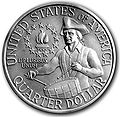

![Reverse of the Bicentennial dollar (Type 1), minted 1975–1976[49]](https://upload.wikimedia.org/wikipedia/commons/thumb/f/f0/1976S_Type1_Eisenhower_Reverse.jpg/120px-1976S_Type1_Eisenhower_Reverse.jpg)
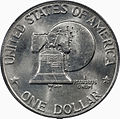









![Sybil Ludington is said to have ridden through the night to advise minutemen that British Redcoats were burning Danbury, Connecticut; these accounts, originating from the Ludington family, are questioned by modern scholars.[62][63][64]](https://upload.wikimedia.org/wikipedia/commons/thumb/1/1d/Sybil_Ludington_stamp.jpg/120px-Sybil_Ludington_stamp.jpg)






